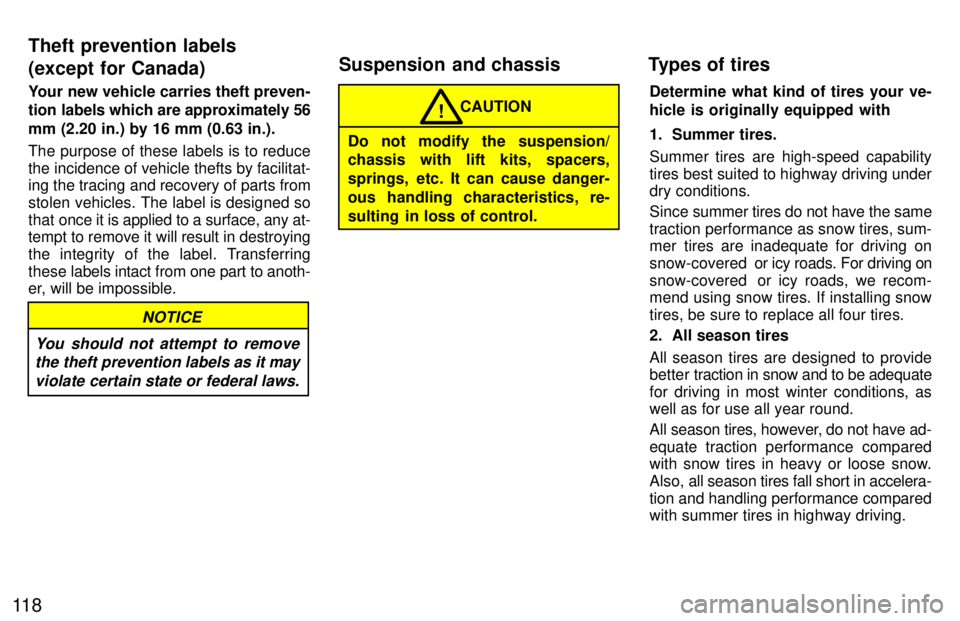Page 73 of 212

69
1/2-ton models 3RZ-FE engine
gear km/h (mph)
1 40 (25)
2 75 (47)
3 115 (71)
4 165 (103)
5VZ-FE engine
gear km/h (mph)
1 40 (25)
2 75 (47)
3 115 (71)
4 165 (103)
Four-wheel drive models
gear km/h (mph) H2º and H4º L4º
1 40 (25) 15 (9)
2 75 (47) 30 (18)
3 115 (71) 40 (25)
4 165 (103) 60 (37)
NOTICE
Do not downshift if you are going faster than the maximum allowable
speed for the next lower gear.
Good driving practice � If it is difficult to shift into reverse, put
the transmission in neutral, release
the clutch pedal momentarily, and then
try again.
� When towing a trailer, in order to main-
tain engine braking efficiency, do not
use the fifth gear.
Be careful when downshifting on a
slippery surface. Abrupt shifting
could cause the vehicle to spin orskid. CAUTION
!
NOTICE
Make sure the vehicle is completely stopped before shifting into
reverse.
The four- wheel drive control lever se-
lects one of the transfer modes below
by the position.
The 4WDº indicator light shows when the
four- wheel drive control lever is in the H4º,
Nº or L4º position.
H2º (high speed position, two- wheel
drive): Lever at H2º
Use this for normal driving on dry hard- sur-
faced roads. This position gives greater
economy, quietest ride and least wear.
H4º (high speed position, four- wheel
drive): Lever at H4º
Use this for normal driving on wet, icy or
snow- covered roads. This position pro-
vides greater traction than two- wheel drive.
Four-wheel drive systemÐ
(a) Four-wheel drive control lever
Page 122 of 212

11 8Your new vehicle carries theft preven-
tion labels which are approximately 56 mm (2.20 in.) by 16 mm (0.63 in.). The purpose of these labels is to reduce
the incidence of vehicle thefts by facilitat- ing the tracing and recovery of parts from
stolen vehicles. The label is designed so
that
once it is applied to a surface, any at-
tempt to remove it will result in destroying
the integrity of the label. Transferring
these la bels intact from one part to anoth-
er, will be impossible.
You should not attempt to remove
the theft prevention labels as it may
violate certain state or federal laws.
NOTICE
CAUTION!
Do not modify the suspension/ chassis with lift kits, spacers,
springs, etc. It can cause danger-
ous handling characteristics, re-
sulting in loss of control. Determine what kind of tires your ve-
hicle is originally equipped with
1. Summer tires.
Summer tires are high-speed capability
tires best suited to highway driving under dry conditions. Since
summer tires do not have the same
traction performance as snow tires, sum-
mer tires are inadequate for driving on
snow-covered or icy roads. For driving on
snow-covered or icy roads, we recom-
mend using snow tires. If installing snow tires, be sure to replace all four tires.
2. All season tires
All season tires are designed to provide
better traction in snow and to be adequate
for driving in most winter conditions, as
well as for use all year round.
All season tires, however, do not have ad-
equate traction performance compared
with snow tires in heavy or loose snow.
Also, all season tires fall short in accelera-
tion and handling performance compared with summer tires in highway driving.
Suspension and chassis Types of tires
Theft prevention labels (except for Canada)
Page 181 of 212

177
To equalize tire wear and help extend
tire life, Toyota recommends that you
rotate your tires approximately every
12000 km (7500 miles). However, the
most appropriate timing for tire rota-
tion may vary according to your driv-
ing habits and road surface condi- tions.
See If you have a flat tireº in Part 4 for tire
change procedure. When rotating tires, check for even wear
and damage. Abnormal wear is usually
caused by incorrect tire pressure, improp-
er wheel alignment, out-of-balance
wheels, or severe braking. WHEN TO USE SNOW TIRES OR CHAINS
Snow tires or chains are recom-
mended when driving on snow or ice.
On wet or dry roads, conventional tires
provide better traction than snow tires. SNOW TIRE SELECTION
If you need snow tires, the same size, construction and load capacity as the
original tires on your Toyota.
Do not use tires other than those men-
tioned above. Do not install studded tires
without first checking local regulations for
possible restrictions.
SNOW TIRE INSTALLATION
Snow tires should be installed on all wheels.
Installing snow tires on the rear wheels
only can lead to an excessive difference
in road grip capability between the front
and rear tires which could cause loss of
vehicle control.
When storing removed tires, you should
store them in a cool dry place.
Mark the direction of rotation and be sure to install them in the same direction when replacing.
Rotating tires
Installing snow tires and chains
Page 208 of 212

204Traction A, B, C
ÐThe traction grades,
from highest to lowest, are A, B, and C,
and they represent the tire's ability to stop
on wet pavement as measured under
controlled conditions on specified govern-
ment test surfaces of asphalt and con-
crete. A tire marked C may have poor trac-
tion performance.
Warning: The traction grade assigned to this tire is based on braking (straight
ahead) traction tests and does not include
cornering (turning) traction.
Temperature A, B, C ÐThe temperature
grades are A (the highest), B, and C, rep-
resenting the tire's resistance to the gen-
eration of heat and its ability to dissipate heat when tested under controlled condi- tions on a specific indoor laboratory test
wheel. Sustained high temperature can cause the material of the tire life, and ex- cessive temperature can lead to sudden
tire failure. The grade C corresponds to a level of performance which all passenger
car tires must meet under the Federal Mo-
tor Vehicle Safety Standard No. 109.
Grades B and A represent higher levels of
performance on the laboratory test wheel
than the minimum required by law. Warning: The temperature grades for this tire
are established for a tire that is proper-
ly inflated and not overloaded. Excessive speed, underinflation, or excessive load- ing, wither separately or in combination, can cause heat buildup and possible tirefailure. This information has been prepared in
accordance with regulation issued by the
National Highway Traffic Safety Adminis-
tration of the U.S. Department of
Transportation Highway Traffic Safety
Administration of the U.S. Department of
Transportation. It provides the purchas- ers and/or prospective purchasers of
Toyota vehicles with information on
truck-camper
loading. Your Toyota dealer
will help answer any auestions you may
have as you read this information.
Camper informationÐ